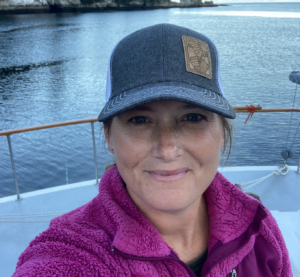Bubbles form curtain
net around prey from below
Is it a fluke?
Why are we sampling?
Where are we sampling?
We conduct two annual surveys: a 6-day survey in April each year and a 10-day survey in conjunction with the Gulf Watch Alaska winter bird and forage fish projects during late September. We focus our efforts on locations where whales have historically been observed foraging in Prince William Sound during the spring, fall, and winter (e.g. Montague Strait, Bainbridge Passage, Port Fidalgo, Port Gravina). The fall combined survey reduces vessel costs while increasing our knowledge of interactions among predators, prey, and habitat.
How are we sampling?
To determine if the whales were preventing herring recovery, we have to know how many herring are being eaten by whales. To answer this we need the number of whales are using Prince William Sound, how long do they remain in the Sound, and what are they eating. Whales can be hard to count because they spend so much time under water where they can’t be seen. We use the unique black and white pattern on the underside of their tail, or flukes to identify individual whales and come up with an estimate of abundance.
By photographing and identifying individual whales, we have created and continue to update a catalog of photographs of all the whales seen in our study. Knowing individual whales helps us understand their behavior, how long do they stick around the Sound? Do they have food preferences? Figuring out what they are eating can be tricky. We track the movements of each whale and determine what each whale eats, although it is difficult to find out what they were eating when they feed beneath the surface. We use a variety of techniques to identify whale prey, including jigs and nets to collect fish and krill near feeding whales and fish finders to distinguish zooplankton from fish. We also collect tissue samples from whales by means of a modified cross-bow to shoot a small stainless steel dart tip the size of a pencil eraser.

AN EXAMPLE OF PREY FROM AN AREA WHERE ACTIVE FEEDING OF HUMPBACK WHALES OCCURRED: EUPHAUSIIDS AND FORAGE FISH.

LIKE FINGERPRINTS, UNIQUE MARKINGS AND DISTINCTIVE TRAILING EDGES ON THE FLUKES ALLOW RESEARCHERS TO RECOGNIZE INDIVIDUAL WHALES.
During summers, local residents and boat operators provide reports of sightings and the Gulf Watch Alaska killer whale project contributes photo-identifications. These reports and photos are used to track whale movements and estimate the total number of humpback whales in Prince William Sound.
What are we finding?
We continue to monitor the steep decline of the local humpback whale population in Prince William Sound following the 2014-2016 northeast Pacific marine heatwave (PMH). Whale counts during 2024 and encounter rates (whales seen /nautical miles surveyed) were on par with 2023, but numbers are still below pre-heatwave estimates. Calf production increased during 2024, with crude birth rates (calves/whales) slightly higher than 2023, a trend that was seen across the eastern Gulf of Alaska and Hawai’i.
Prior to the heatwave, humpback whales in Prince William Sound fed primarily on adult Pacific herring, especially when herring aggregated in large shoals during the spring, fall, and winter. In 2023, we estimated that 1.4% of the pre-spawning biomass of herring was consumed by whales during the fall and 0.9 % during the spring. This contrasts sharply with the peak annual consumption of 38.1% in 2013. Consumption rates for 2022 and 2023 remained low. Given the higher herring abundance in 2024 and similar whale counts to 2023, we suspect the consumption rates by whales on herring will be lower in 2024. The decline in the number of whales in Prince William Sound, either through mortality or emigration, along with a shift towards euphausiids as a prey source, has removed some of the predation pressure on herring, potentially aiding the recovery of herring seen within Prince William Sound.
You can check out the humpback fluke identification catalog showing some of the whales monitored under this program at: Prince William Sound humpback whale fluke identification catalog.










